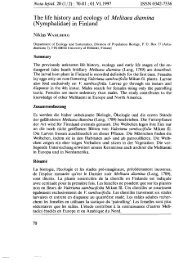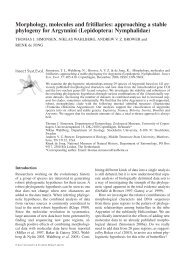Phylogenetic relationships of butterflies of the tribe Acraeini ...
Phylogenetic relationships of butterflies of the tribe Acraeini ...
Phylogenetic relationships of butterflies of the tribe Acraeini ...
You also want an ePaper? Increase the reach of your titles
YUMPU automatically turns print PDFs into web optimized ePapers that Google loves.
526 K.L. Silva-Brandão et al. / Molecular <strong>Phylogenetic</strong>s and Evolution 46 (2008) 515–531genus Pardopsis also appeared within <strong>the</strong> Argynnini cladewith a high PP value.3.2. Evolution <strong>of</strong> host plant useAccording to <strong>the</strong> character optimization <strong>of</strong> <strong>the</strong> hostplant families used by each species <strong>of</strong> <strong>Acraeini</strong>, <strong>the</strong> ancestralstate <strong>of</strong> <strong>the</strong> <strong>tribe</strong> is <strong>the</strong> use <strong>of</strong> host plants <strong>of</strong> <strong>the</strong> familyPassifloraceae, and most <strong>of</strong> <strong>the</strong> basal Acraea + Bematistesfeed on plants <strong>of</strong> this family (Fig. 5). The species <strong>of</strong> Acraea<strong>of</strong> this basal clade also feed on Violaceae. The clade joining<strong>the</strong> remaining Acraea (‘‘Old World Actinote”) is characterizedby feeding mostly on Urticaceae, with some specieshighly polyphagous—<strong>the</strong> branch appears generally as‘‘equivocal” to this polyphagous species. The host plantused by <strong>the</strong> ancestor <strong>of</strong> <strong>the</strong> South-American <strong>Acraeini</strong> cladeis equivocal, but if we consider <strong>the</strong> whole clade but Alt. eresia(whose host plant is unknown) <strong>the</strong> ancestor host plant<strong>of</strong> this group may have been Asteraceae, and all Neotropical<strong>Acraeini</strong> with a well known life cycle feed on plants <strong>of</strong>this family only. Feeding on this host plant family is characteristic<strong>of</strong> <strong>the</strong> ancestor <strong>of</strong> <strong>the</strong> genus Actinote (s. str.). Thephylogenetic signal obtained by <strong>the</strong> modified PTP test wassignificant (P = 0.003), suggesting that <strong>the</strong> distribution <strong>of</strong>this trait among taxa can be explained by <strong>the</strong>ir phylogenetic<strong>relationships</strong>.4. Discussion4.1. The internal <strong>relationships</strong> <strong>of</strong> HeliconiinaeAlthough <strong>the</strong> main subject <strong>of</strong> this study has been <strong>the</strong><strong>relationships</strong> within <strong>the</strong> <strong>tribe</strong> <strong>Acraeini</strong>, it is worth discussing<strong>the</strong> position <strong>of</strong> <strong>the</strong> <strong>tribe</strong> within <strong>the</strong> subfamily Heliconiinae.Even with all <strong>the</strong> recent advances in <strong>the</strong> systematics <strong>of</strong>Nymphalidae, <strong>the</strong> affinities <strong>of</strong> <strong>the</strong> <strong>tribe</strong> <strong>Acraeini</strong> within <strong>the</strong>Heliconiinae continue to be undefined and controversial.The recent phylogenetic proposal <strong>of</strong> Penz and Peggie(2003) for Heliconiinae, based on characters <strong>of</strong> early stagesand adult morphology, showed a polytomy among <strong>the</strong> fourmajor clades in <strong>the</strong> trees obtained with equally weightedcharacters; however, <strong>the</strong> successive approximation weightinganalyses resulted in a better resolved tree, with <strong>the</strong><strong>Acraeini</strong> appearing as <strong>the</strong> sister group <strong>of</strong> Heliconiini+ (Vagrantini + Argynnini). The same results werefound by Freitas and Brown (2004) with independent datasets <strong>of</strong> morphological characters from adults and immatures.Alternative hypo<strong>the</strong>ses were proposed by Brower(2000) and Wahlberg et al. (2003b, 2005), with <strong>the</strong> <strong>tribe</strong>Argynnini appearing as sister to <strong>Acraeini</strong> + Heliconiini.The taxonomic sampling within Heliconiinae in <strong>the</strong>se studies,however, is too limited (usually one or two taxa representingeach <strong>tribe</strong>) to permit fur<strong>the</strong>r discussion on <strong>the</strong> tribal<strong>relationships</strong>. Here we found two different results in relationto <strong>the</strong> tribal <strong>relationships</strong> within Heliconiinae,although our sample does not include many representatives<strong>of</strong> o<strong>the</strong>r <strong>tribe</strong>s outside <strong>Acraeini</strong>. The results achieved by <strong>the</strong>Bayesian phylogenetic hypo<strong>the</strong>sis are similar to that foundby o<strong>the</strong>r studies, with Vagrantini + Argynnini (containingPardopsis) sister to Heliconiini (+Cethosiini) + <strong>Acraeini</strong>.On <strong>the</strong> o<strong>the</strong>r hand, <strong>the</strong> MP consensus tree shows <strong>the</strong> <strong>tribe</strong>Heliconiini sister to <strong>the</strong> o<strong>the</strong>r three <strong>tribe</strong>s.The monophyly <strong>of</strong> <strong>the</strong> <strong>tribe</strong> <strong>Acraeini</strong> was recovered inall results <strong>of</strong> Penz and Peggie (2003) and Freitas and Brown(2004) (with Pardopsis as part <strong>of</strong> <strong>Acraeini</strong> in both studies),and <strong>the</strong> present study has also recovered <strong>the</strong> monophyly <strong>of</strong><strong>the</strong> <strong>tribe</strong> <strong>Acraeini</strong> (s. str.) in all MP and Bayesian analyses,although all results have shown that Pardopsis does notbelong to <strong>Acraeini</strong>. The monotypic genus Pardopsis hasbeen considered as part <strong>of</strong> <strong>Acraeini</strong> and sister to all o<strong>the</strong>rgenera <strong>of</strong> this <strong>tribe</strong> (Penz and Peggie, 2003; Freitas andBrown, 2004). However, this taxon was never included ina molecular study before, and <strong>the</strong> results <strong>of</strong> <strong>the</strong> presentanalyses showed that <strong>the</strong> genus is in fact part <strong>of</strong> Argynnini.The position <strong>of</strong> Pardopsis within Argynnini was recoveredby <strong>the</strong> Bayesian analysis with a high posterior probabilityvalue (Fig. 4), and in <strong>the</strong> consensus MP tree with a weaksupport, and we consider it not to be within <strong>the</strong> <strong>tribe</strong><strong>Acraeini</strong> (s. str.), as defined in this study. Some clues about<strong>the</strong> position <strong>of</strong> Pardopsis can be obtained from <strong>the</strong> immaturestages (see Van Son, 1963), which share several characterstates with <strong>the</strong> Argynnini, as discussed in Freitas (1999).These character states include, for example, <strong>the</strong> egg withseveral longitudinal ridges anastomosing near half <strong>the</strong>height, and <strong>the</strong> subdorsal prothoracic scoli longer than<strong>the</strong> o<strong>the</strong>rs (both present in Euptoieta hegesia—Freitas,1999). A future study with better taxonomic sampling <strong>of</strong>Argynnini and Vagrantini, and <strong>the</strong> addition <strong>of</strong> morphologicaldata, will be crucial to define <strong>the</strong> real affinities <strong>of</strong> thispuzzling genus.The position <strong>of</strong> Cethosia within <strong>the</strong> Heliconiinae hasbeen discussed in several recent papers, but still remainscontroversial (Penz and Peggie, 2003). Brower (2000)shows Cethosia as sister to <strong>Acraeini</strong> + Heliconiini. In Freitasand Brown (2004), Cethosia is <strong>the</strong> sister group <strong>of</strong> Vindula(=Vagrantini <strong>of</strong> Penz and Peggie, 2003), and <strong>the</strong>successive weighting analysis defined this pair as sister toHeliconiini. The same general topology was also foundby Penz and Peggie (2003), and <strong>the</strong> Bayesian analysis in<strong>the</strong> present study shows Cethosia as sister to Heliconiini(Fig. 4). Harvey (1991), however, proposes that Cethosiabelongs to its own <strong>tribe</strong>, Cethosiini, sister to <strong>the</strong> <strong>Acraeini</strong>,based on an extremely well developed ‘‘gland sous-papillaire”in <strong>the</strong> female abdomen, although in <strong>the</strong> ‘‘Addendum”<strong>of</strong> <strong>the</strong> same work <strong>the</strong> author places Cethosia into<strong>Acraeini</strong> and abandons Cethosiini. Clearly a broad molecularstudy <strong>of</strong> <strong>the</strong> subfamily Heliconiinae is needed with acomprehensive sampling <strong>of</strong> species in <strong>the</strong> subfamily to clarify<strong>the</strong> position <strong>of</strong> Cethosia.4.2. The <strong>tribe</strong> <strong>Acraeini</strong>Our results on <strong>the</strong> <strong>relationships</strong> within <strong>Acraeini</strong> are similarto <strong>the</strong> proposal <strong>of</strong> Pierre (1987) (Fig. 2), but due to <strong>the</strong>





